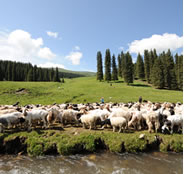
|
Out of steppe
We also found that the
grasslands were not
adapting as quickly to
climate change as one
would expect.
Most studies that have investigated the impact of climate change on grassland areas have found that spring
comes earlier as temperatures rise, and autumn begins later. However, this was not what Jianchu Xu, the World
Agroforestry Centre's coordinator for East-Asia, and his research colleague, Haiying Yu, found when they looked
at the onset of spring growth on the Tibetan plateau, using remote sensing data from 1982 to 2006.
As the annual temperatures steadily rose, the date at which the grass began to grow shifted from early June to late May just as you would expect. But all of a sudden, in the late 1990s, the trend was reversed: the growing season began later as the years passed, even though the average temperatures continued to rise. Jianchu and
Haiyang shared their findings with Eike Luedeling, who had been researching the influence of winter chill on
temperate fruits and nuts (see related story).
"The more we looked into it, the more likely it seemed that reduced winter chill was at work," says Luedeling. The steppe vegetation on the Tibetan plateau is extremely sensitive to temperature change, and the declining winter chill factor meant that the grasses were taking longer to break their winter dormancy. "We also found that the grasslands were not adapting as quickly to climate change as one would expect," he says. Grass species that are better adapted to a warmer climate have yet to move on to the steppes. This may be because most propagate vegetatively rather than by seed. Whatever the reason, the growing season is becoming shorter, which is bad news for Tibet's pastoralists.
Yu H, Luedeling E and Xu J. 2010. Winter and spring warming result in delayed spring phenology on the Tibetan plateau. Proceedings of the National Academy of Sciences of the United States of America, 107 (51). doi: 10.1073/pnas.1012490107. |

